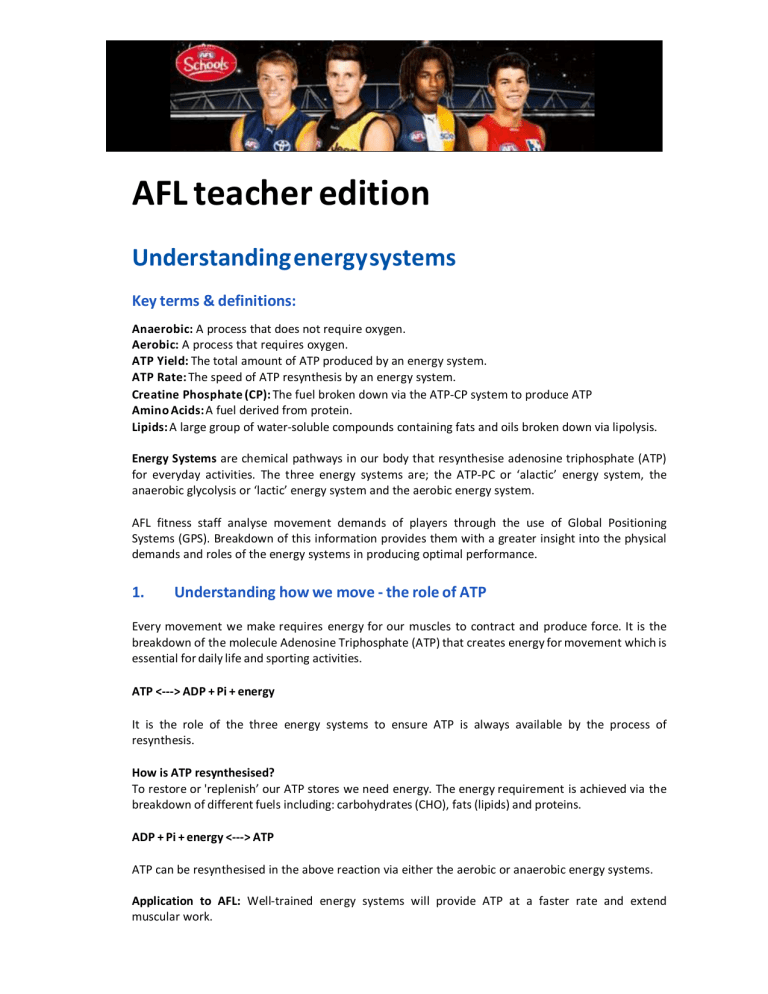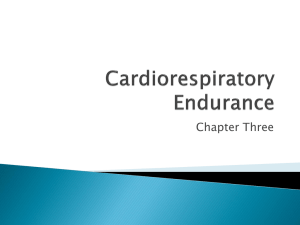
AFL teacher edition Understanding energy systems Key terms & definitions: Anaerobic: A process that does not require oxygen. Aerobic: A process that requires oxygen. ATP Yield: The total amount of ATP produced by an energy system. ATP Rate: The speed of ATP resynthesis by an energy system. Creatine Phosphate (CP): The fuel broken down via the ATP-CP system to produce ATP Amino Acids: A fuel derived from protein. Lipids: A large group of water-soluble compounds containing fats and oils broken down via lipolysis. Energy Systems are chemical pathways in our body that resynthesise adenosine triphosphate (ATP) for everyday activities. The three energy systems are; the ATP-PC or ‘alactic’ energy system, the anaerobic glycolysis or ‘lactic’ energy system and the aerobic energy system. AFL fitness staff analyse movement demands of players through the use of Global Positioning Systems (GPS). Breakdown of this information provides them with a greater insight into the physical demands and roles of the energy systems in producing optimal performance. 1. Understanding how we move - the role of ATP Every movement we make requires energy for our muscles to contract and produce force. It is the breakdown of the molecule Adenosine Triphosphate (ATP) that creates energy for movement which is essential for daily life and sporting activities. ATP <---> ADP + Pi + energy It is the role of the three energy systems to ensure ATP is always available by the process of resynthesis. How is ATP resynthesised? To restore or 'replenish’ our ATP stores we need energy. The energy requirement is achieved via the breakdown of different fuels including: carbohydrates (CHO), fats (lipids) and proteins. ADP + Pi + energy <---> ATP ATP can be resynthesised in the above reaction via either the aerobic or anaerobic energy systems. Application to AFL: Well-trained energy systems will provide ATP at a faster rate and extend muscular work. AFL teacher edition Video: Specific tests employed by the AFL draft combine to individually screen all invitees. Click to play 2. Fueling the energy systems Creatine Phosphate (CP): is the most important fuel in maximal-effort exercise of a short duration (110 seconds). It is only stored in the muscle in small amounts and does not require oxygen to break down (anaerobic). Energy system(s): ATP-CP ‘alactic’ Intensity: Supramaximal AFL example: Centre bounce Carbohydrates (CHO): are an important fuel for activities lasting from 2 minutes to approximately 2 hours. CHO’s have the potential to be broken down anaerobically or aerobically depending on the nature of the activity. CHO’s are found in the blood as glucose and stored in the muscle and liver as glycogen. Energy system(s): Aerobic & anaerobic glycolysis Intensity: High- very high AFL example: A sprint from one end of the ground to the other Fats (Lipids): are an important source of fuel for sub-maximal events lasting more than 2-3 hours. Fats can only be broken down aerobically and resynthesize ATP at a slower rate than CHO. However, fats provide a greater yield of ATP compared to CHO, extending exercise duration. Fats are found in the blood as free fatty acids (FFA’s) and stored in muscle and adipose tissue as triglycerides. Energy system: Aerobic Intensity: Low-moderate AFL example: Entire duration of an AFL game Protein (amino acids): are utilised by the body during aerobic exercise when CHO and lipid stores are low. This can occur with events lasting longer than 3 hours (ultra-marathon). Whilst protein does not contribute significantly to energy production in this scenario, it is an essential nutrient that serves as a building block for muscle tissue growth and repair. Protein is the major structural component of all cells in the body, including muscle. AFL teacher edition Application to AFL: The various activities, and therefore, demands for energy in the sport of AFL mean that all three energy systems play an important role in a player’s performance. Class activity: As a group, discuss the fuel contribution throughout the following stages of a game using the examples below. 1. At the start of the game, a full forward leads hard, marks and kicks for goal. 2. A midfielder sprints the entire length of the ground to gather an opponent. 3. At the completion of the game, a defender who has had 6 goals kicked on him and played 90% of game time. 3. ATP - CP or 'alactic' energy system The ATP-CP (alactic) energy system is an anaerobic energy system which is dominant in short explosive activities. It is considered the most powerful of the three energy systems due to its high rate of ATP resynthesis but it has the smallest capacity for ATP production. Fuel: Creatine phosphate (CP) Intensity: Supramaximal Dominant: Activities up to 15 sec Recovery: Passive Application to AFL: AFL players need energy for explosive movements such as short bursts of speed when chasing down an opponent or avoiding one, leaping up for a spectacular mark or to make the distance on a long kick. Positions in the forward line and back line would generally have more time to passively recover their PC stores due to the nature of the game. Video: Ben Graham kicks the ball 105 m out from full back. Click to play AFL teacher edition 4. Anaerobic glycolysis or 'lactic' energy system The anaerobic glycolysis system is the second most powerful energy system and as such, supplies adenosine triphosphate (ATP) at a slower rate than the ATP-CP system. It is considered limited due to an accumulation of metabolic by-products, namely hydrogen ions (H+). Fuel: Carbohydrates (CHO), muscle glycogen and glucose Intensity: Supramaximal Dominant: Activities up to 75 sec Recovery: Active Application to AFL: The ability to sprint from one end of the ground to the other is attributable to the anaerobic glycolysis system. A player with a better developed system would be able to maintain a higher speed over this distance. Video: Patrick Dangerfield wins the AFL Grand Final sprint Click to play 5. Aerobic energy system The aerobic energy system provides the greatest yield of ATP but at the slowest rate of resynthesis. Breaking down CHO's and fats with the aid of oxygen (02), the aerobic energy system can produce enough energy to exercise indefinitely. It can provide 30 to 50 times as much ATP as the two anaerobic energy systems combined. Note: the aerobic energy system plays an important role in recovery for both anaerobic energy systems to metabolise by-products and replenish fuel stores. Fuels: Carbohydrates (CHO), fats Intensity: Low-maximal Dominant: Activities 2 min to hours Recovery: Active Application to AFL: An AFL match lasts approximately 120 minutes. Players must be able to perform high speed efforts AFL teacher edition and continue running out a game if the team is to be successful. A well trained aerobic system assists in recovery of the anaerobic energy systems allowing for an increased number of high intensity efforts towards the end of the match and the ability to keep ‘running’. Video: Essendon players completing a 2 km time trial during pre season training. Click to play 6. Energy system interplay The three energy systems work together to meet the energy demands of an AFL rules game. However, throughout any activity, only one energy system provides the largest amount of ATP i.e. the dominant energy system. Activities of an AFL game will differ in reliance on the contribution from all three energy systems depending on intensity and duration of the effort. A supramaximal intensity effort (above VO2max) will be fueled by either the ATP-CP system or the anaerobic glycolysis system predominately. As the match continues and fatigue begins to set in, these efforts may reduce in intensity resulting in a greater contribution from the aerobic energy system. Insufficient rest time and depletion of fuels in relation to the anaerobic energy systems will influence their energy contribution. Key examples within AFL: An AFL midfielder arrives to the fall of the ball during a contest on the wing and is tackled heavily by an opponent. The ball is spilt out during the tackle and the midfielder quickly rebounds to collect the ball and handballs immediately to a team member. The team member handballs back to the midfielder who then kicks the ball into the forward 50m and follows the ball by running hard to the contest. Within this example we see the use of repeat efforts, lateral movements and sprinting, which significantly impacts the energy system interplay. AFL energy demands: The following 2 pie charts demonstrate an AFL player’s energy system contribution at the 5 and 20 second stage of a passage of play. The high intensity efforts are made-up of activities such as sprints, tackles and disposals, each requiring short bursts. AFL teacher edition Video: Lewis Jetta sprints from half way to score a goal for the Sydney Swans Click to play Class activity: 1. 2. 3. Using the clip above, what is the predominant energy system in this case? If this was immediately preceded by a 20 m sprint, what would you expect the dominant energy system to be? Refer to the time course graph below to assist your response. Comment on the role of the aerobic system following Jetta’s goal. Image: Time course graph of energy system contribution



